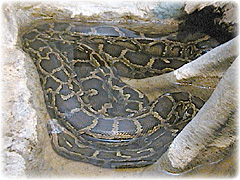Difference between revisions of "Burmese Python"
Jump to navigation
Jump to search
(Created page with '{{unfinished}} 250px|thumb|right|'''Boa constrictor''' ©RVC and its licensors, Peer Zwart and Fredric Frye. All rights reserved ==Int…') |
|||
| (9 intermediate revisions by 4 users not shown) | |||
| Line 1: | Line 1: | ||
| − | {{ | + | {{unfinished}} |
| − | [[Image:Burmese_python_240x180_border.jpg|250px|thumb|right|''' | + | [[Image:Burmese_python_240x180_border.jpg|250px|thumb|right|'''Boa constrictor''' ©RVC and its licensors, Peer Zwart and Fredric Frye. All rights reserved]] |
==Introduction== | ==Introduction== | ||
| − | The Burmese python (''Python molurus'') is a python | + | The Burmese python (''Python molurus'') is a python (family Boidea). Their life span may be 10-15 years. |
==Morphology== | ==Morphology== | ||
Burmese pythons have an intricate pattern of markings of irregular brown blotches on a yellow background. The Burmese python is widely bred in captivity and comes in a number of mutant forms including albino. They can grow rapidly, attaining 2 metres in length in their first year and perhaps reaching 8 metres. | Burmese pythons have an intricate pattern of markings of irregular brown blotches on a yellow background. The Burmese python is widely bred in captivity and comes in a number of mutant forms including albino. They can grow rapidly, attaining 2 metres in length in their first year and perhaps reaching 8 metres. | ||
| Line 14: | Line 14: | ||
*Humidity – A humidity of approximately 60% is preferred. | *Humidity – A humidity of approximately 60% is preferred. | ||
*Diet – A variety of prey can be fed and includes mice, rats, rabbits, chickens, and guinea pigs. Feed once to twice every 10 days. | *Diet – A variety of prey can be fed and includes mice, rats, rabbits, chickens, and guinea pigs. Feed once to twice every 10 days. | ||
| − | *Reproduction – Burmese pythons are relatively easy to breed in captivity. They are oviparous and usually lay between 30-50 eggs (up to 100 recorded). The female incubates the eggs by curling around them and "twitching" her muscles. The young are 45 to 60 cm at birth. | + | *Reproduction – Burmese pythons are relatively easy to breed in captivity. They are oviparous and |
| − | *Veterinary considerations - Common medical problems include diseases associated with low cage temperatures such as respiratory infections and necrotic stomatitis, anorexia | + | usually lay between 30-50 eggs (up to 100 recorded). The female incubates the eggs by curling around them and "twitching" her muscles. The young are 45 to 60 cm at birth. |
| − | + | *Veterinary considerations - Common medical problems include diseases associated with low cage | |
| − | + | temperatures such as respiratory infections and necrotic stomatitis, anorexia and obesity. | |
| − | |||
| − | |||
| − | |||
| − | |||
| − | |||
| − | |||
| − | |||
| − | |||
| − | |||
| − | |||
| − | |||
Revision as of 17:58, 18 March 2010
| This article is still under construction. |
Introduction
The Burmese python (Python molurus) is a python (family Boidea). Their life span may be 10-15 years.
Morphology
Burmese pythons have an intricate pattern of markings of irregular brown blotches on a yellow background. The Burmese python is widely bred in captivity and comes in a number of mutant forms including albino. They can grow rapidly, attaining 2 metres in length in their first year and perhaps reaching 8 metres.
Free-Living
- Distribution – Burmese pythons are native to India, Ceylon and southeast Asia.
- Habitat – They are often found near water, and are both terrestrial and arboreal.
- Diet – Burmese pythons constrict mammals and birds.
Captivity
- Cage – Terrestrial and arboreal requirements are necessary and the size of cage should be related to the size of snake.
- Temperature - Optimum air temperature during the day is 29°C to 35°C (85°F to 95°F) and at night is 24°C to 27°C (75°F to 80°F). A temperature gradient should be provided so that the snake can move to slightly cooler or warmer temperatures.
- Humidity – A humidity of approximately 60% is preferred.
- Diet – A variety of prey can be fed and includes mice, rats, rabbits, chickens, and guinea pigs. Feed once to twice every 10 days.
- Reproduction – Burmese pythons are relatively easy to breed in captivity. They are oviparous and
usually lay between 30-50 eggs (up to 100 recorded). The female incubates the eggs by curling around them and "twitching" her muscles. The young are 45 to 60 cm at birth.
- Veterinary considerations - Common medical problems include diseases associated with low cage
temperatures such as respiratory infections and necrotic stomatitis, anorexia and obesity.
